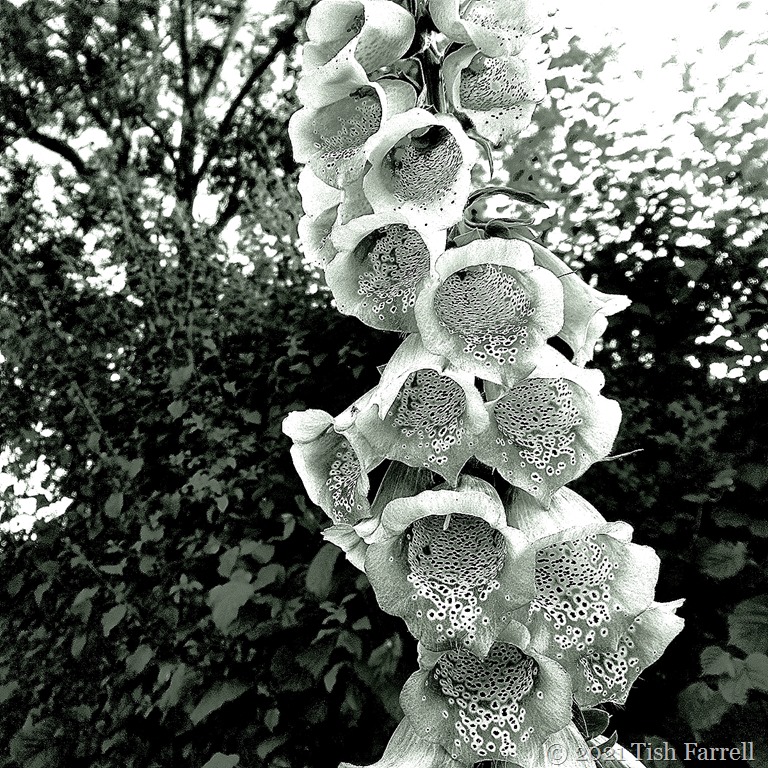Foxgloves – also known as Fairy Gloves, Lion’s Mouth and Witches’ Fingers – have long featured in herbal medicine, the leaves used as infusions and compresses. But it was in the 1780s that William Withering, Shropshire-born botanist and physician, discovered the plant’s most potent use is for the slowing and strengthening of the heartbeat. In 1785 he published An account of the foxglove in which he outlined his findings and the results of his clinical trials. Foxgloves are also highly toxic, so getting the precise dosage was absolutely critical. Nevertheless, efficacy won over potential risk and eventually the active principles, digitoxin and digoxin were isolated and purified. These are still used in mainstream medicine, though the source of choice is a European species Digitalis lanata.
In his Flora Britannica, Richard Mabey also tells the story of how my corner of Shropshire on Wenlock Edge played its part during World War II when the import of European foxglove supplies was foiled by war. Apparently the foxgloves growing on certain areas of eroded limestone were especially potent. And until 1949 large quantities of the plants were also gathered across the county by members of Women’s Institutes, the leaves put to dry in nets in bakery lofts and clothes drying rooms.
The foxglove in the photo is growing in a shady corner of the garden. It brought itself there a while back and in real life is of a colour more rosy pink than purple. In monochrome, though, there’s a compelling eeriness about it. Witches’ thimbles, eh.




Oh Tish, your digitalis photos are wonderful. Excellent post for this week. 😀
Thank you, Cee. Loving all that praise!
I often wonder how many people “passed” while trying to decide how much was the right dosage.
I was thinking that myself. I must see if his book is still around in some form.
As good as B&W flower pictures get, yours are. I’m not especially fond of flowers in monochrome since to me, color and flowers are born to be together, but I’ll give it a try. Maybe orchids. They are sharply delineated, so they might work.
Oh yes. Do give orchids a go.
Got to love Foxgloves, tall, stately, beautiful, self-seed everywhere and the bumblebees adore them!
Great image Tish.
I love them to bits, Brian. The way they come and go in the garden. The way they try to block the door to other half’s shed!
The monochrome does bring out the details of the individuals flower petals. It’s wonderfully photographed Tish. And interesting information.
Thank you, Agnes. I like the way the monochrome creates a very particular constellation effect in each flower.
B&W does bring out details but these flowers are so beautiful that I crave them in color. 🙂
janet
I’m sure there will be some coming along 🙂
Such great patterns. I have never thought about photographing these in B&W. It really works though.
Those ‘landing-platform’ spots seem to loom a bit in b & w.
They do stand out 😂
One of my white ones this year has no landing spots!
I’ve got a white one like that too.
Fascinating how much they vary
I love foxglove. We have plenty of them here too at the moment. I didn’t know it was the source of digitalis!
Alison
It’s amazing that the drug has been in use for so long. Good old foxgloves.
PS Love the B&W photos of it.
A.
Thank you, Alison.
They do look eerie in black and white, as if they were strange cells designed to suck us up and channel us to the never-never. It is good that in reality they are very charming. 🙂
Now you’ve planted that sucking-up image in my mind, I think I will keep a close eye on the ones in the garden. All may not be what it seems 😉
😀 😀 😀
Loving them in B&W . . I wonder what made they experiment with foxgloves in the first place!
Withering was apparently talking to some village herbalist about one of her preparations and decided foxglove was the active part of her potion.
The monochrome of the plant shows up the intricate detail of the plant.
My thoughts too.
As a child I was actually told the story of William Withering’s discovery of the drug ‘digitalis’ by a local historian (and friend of my Grandmother) who both lived at High Ercall which is only a few miles from Wellington. For some reason this story has always stuck with me along with another about Oliver Cromwell’s troops firing off a cannon shot that struck the church roof. Funny the facts you remember!
Love foxgloves by the way. Who doesn’t? The flowers are simply stunning and just so perfectly shaped for bees to crawl inside that I bet they look irresistible to our apian friends.
More synchronicity through time and space. Or is that diachroneity. V. interesting connection anyway 🙂
Triffid!!!
Triffid indeed, Widders. Now I’m really worried.